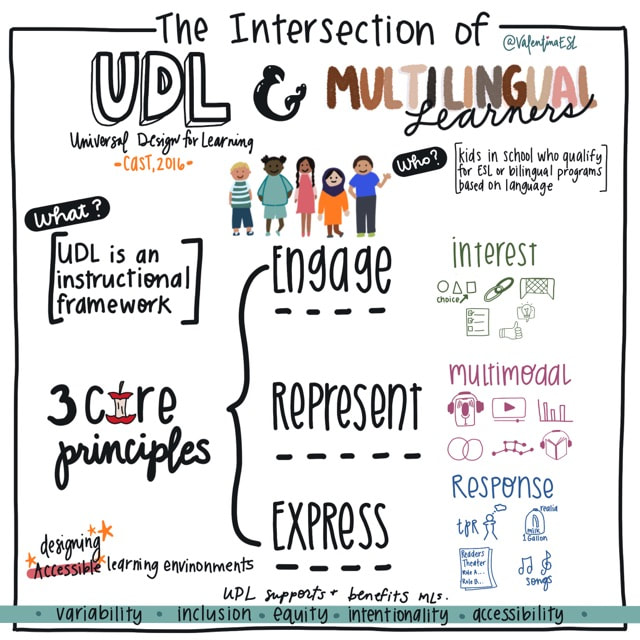|
Multilingual learners (MLs) are amongst the fastest growing population in the United States. MLs come from diverse linguistic and cultural backgrounds. The assets they bring to classrooms are sometimes underrecognized leaving these students struggling linguistically and academically. Many teachers of MLs want to provide instruction that meets their needs but find themselves not knowing how to help and feeling overwhelmed. This is where Universal Design for Learning (UDL) enters and has been known to support and benefit MLs. What is UDL? UDL an educational framework that creates inclusive learning environments for all students. It involves providing multiple means of representation, expression, and engagement to accommodate diverse learning needs. CAST defines UDL as “a framework to improve and optimize teaching and learning for all people based on scientific insights into how humans learn.” This research-based set of principles for learning was first introduced in the 1990s by Anne Meyer and David Rose. They aim to create lessons that are accessible and effective for all students, removing any barriers to learning. UDL focuses on students’ strengths, what they can do and adjusts based on their needs. Let’s take a closer look at the components of the word Universal Design for Learning. Universal- Think of a universal remote control that can be used with any brand name television. Universal in UDL means building curriculum and lessons that can be understood by all students. Design- When we design for those in the margins, it works better for everyone. Imagine a building with a ramp and automatic door. This building is designed to work for many customers, not just some. When we design lessons for students in the margins, they too, work better for everyone. Lessons with multiple entry points, multimodal lessons, and lessons that are flexible to meet students’ needs. Learning- Effective instruction is not limited by a one-size-fits-all approach. On the other hand, learning happens differently and at different rates. UDL includes 3 main principles: engagement, representation, and expression. Examples of Using UDL to Support English Learners Engagement: the why (affective)
MLs can benefit greatly from the implementation of UDL principles in the classroom. Effective instruction for MLs includes the development of language, validation and inclusion of culture, and collaboration with peers. UDL provides a framework for lessons and instruction that allow MLs to access, process, and express information and fully engage. The Benefits of UDL for Multilingual Learners Increased engagement: By providing multiple ways for students to access and engage with the content, UDL can help multilingual learners feel more connected to the learning process and motivated to participate. Improved comprehension: UDL allows multilingual learners to access information in ways that align with their language and cultural backgrounds. This can help them better understand the content and make connections to their prior knowledge. COMPREHENSIBLE INPUT Enhanced expression: By providing multiple ways for students to express their understanding of the content, UDL allows multilingual learners to demonstrate their knowledge and skills in ways that align with their strengths and preferences. LOW-STRESS OUTPUT Using UDL as an approach to lesson planning with Multilingual learners...
UDL Strategies for Multilingual Learners Provide multiple modes of representation: Teachers can use a variety of visual aids, such as pictures, diagrams, and videos, to support multilingual learners' comprehension of the content. This can help students make connections between the visual representation and the language used to describe it. Use multimedia resources: Teachers can provide multimedia resources, such as audiobooks or videos with captions, to support multilingual learners' listening and comprehension skills. Use cooperative learning strategies: Teachers can use cooperative learning strategies to encourage multilingual learners to interact with their peers and practice their language skills. This can help students develop their language skills in a supportive and engaging environment. Provide multiple means of expression: Teachers can provide multiple ways for students to demonstrate their understanding of the content, such as written assignments, oral presentations, and multimedia projects. This can help multilingual learners showcase their strengths and express their understanding of the content in ways that align with their linguistic and cultural backgrounds. Incorporate culturally responsive teaching: Teachers can incorporate culturally responsive teaching strategies that recognize and honor the linguistic and cultural diversity of their students. This can help multilingual learners feel valued and respected in the classroom, which can improve their engagement and motivation to learn. It doesn’t make sense to expect students to mold themselves into our lesson plans or our curriculum. That may be why it’s challenging to pull out a lesson from years ago and use it with the kids we have in front of us today. Every year the students are different. They have different needs and the world they are living in is different also. Instead, as lesson designers, we can use UDL as an approach that adapts to our students. In the book, Breaking Down the Wall (2020), Margo Gottlieb and Andrea Honigsfeld share that even assessments should be planned with UDL in mind.
The bottom line is that UDL serves MLs a healthy dose of equitable and accessible instruction. UDL is a powerful framework that can support the academic success of multilingual learners by providing multiple ways for them to access, process, and express information. When we incorporate UDL strategies in classrooms, we can create more inclusive and engaging learning environments that support the diverse needs and strengths of all students. Resources: Calderón Margarita. (2020). Breaking down the wall: essential shifts for English learners success. Thousand Oaks, California.: Corwin. Haas, E., & Brown, J. E. (2019). Supporting English learners in the classroom: best practices for distinguishing language acquisition from learning disabilities. New York, NY: Teachers College Press. Understood: For Learning and Thinking Differences. (n.d.). Retrieved from https://www.understood.org/en?_ul=1*qgdhee*domain_userid*YW1wLUZMRkFpVzgtTUVJQWE2Mi01NkEtbkE. Until learning has no limits. (2020, January 22). Retrieved from http://www.cast.org/?utm_source=udlguidelines&utm_medium=web&utm_campaign=none&utm_content=header Comments are closed.
|
Categories
All
|



 RSS Feed
RSS Feed
